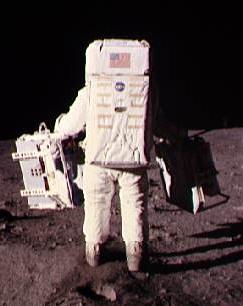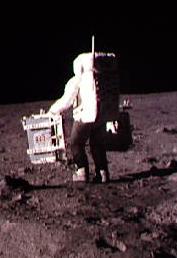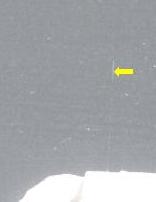
|
|
Fig. 1 - Apollo LMP Buzz Aldrin carries EASEP
equipment to its deployment location. (NASA:
AS11-40-5942)
|
|
|

|
|
Fig. 2 - Aldrin, a few seconds after Fig. 1 was
taken. (NASA: AS11-40-5943)
|
|
|
|
 In Fig. 1, Buzz Aldrin
is carrying the EASEP experiments toward the deployment site. There
is no antenna on top of his PLSS. But in Fig. 2, supposedly taken
only a few seconds later, his antenna is clearly visible. This
discrepancy can't have occurred if the photos were taken only a few
seconds apart. In Fig. 1, Buzz Aldrin
is carrying the EASEP experiments toward the deployment site. There
is no antenna on top of his PLSS. But in Fig. 2, supposedly taken
only a few seconds later, his antenna is clearly visible. This
discrepancy can't have occurred if the photos were taken only a few
seconds apart.

|
|
Fig. 3 - The yellow arrow indicates the antenna in
Fig. 1, which has been enlarged and
intensified. The antenna is seen edge-on in this view and
is thus nearly invisible to the camera. (NASA:
AS11-40-5942, enhanced)
|
|
|
Unlike the antennas on portable radios and automobiles, the VHF
antennas on the astronauts' backpacks were not metal tubes, but flat
metal strips painted white on one side and black on the other. And so
when they are seen edge-on (i.e., from the astronaut's front or back),
they tend to disappear against the dark background. But when
presented broadside (i.e., from the astronaut's side) to the camera
they appear bright and prominent. In Fig. 2 Aldrin has turned
slightly to the left and presented the broad face of the antenna.
The antennas are meant to be folded down when entering or leaving
the LM. In a few of the later missions you can see astronauts with
the antenna folded down because they have just emerged from the LM or
are just about ready to enter it. The other astronaut must fold down
the antenna.
This illustrates two important points about Apollo photographs,
especially those available on the Internet. First is resolution. The
images commonly available are scanned at a low resolution so that the
resulting file will transfer faster over the network. The price for
this speed is the loss of detail. Conspiracists that complain about
missing detail should work from prints, or at least from
high-resolution scans.
It also illustrates the lossy compression in JPEG picture
encoding. Even high-resolution JPEGs can lose some detail when they
are compressed to save file space. Even if the thin edge of the
antenna had been originally visible in the digital image above, it's
likely that JPEG encoding would have gobbled up that detail.


|









 In Fig. 1, Buzz Aldrin
is carrying the EASEP experiments toward the deployment site. There
is no antenna on top of his PLSS. But in Fig. 2, supposedly taken
only a few seconds later, his antenna is clearly visible. This
discrepancy can't have occurred if the photos were taken only a few
seconds apart.
In Fig. 1, Buzz Aldrin
is carrying the EASEP experiments toward the deployment site. There
is no antenna on top of his PLSS. But in Fig. 2, supposedly taken
only a few seconds later, his antenna is clearly visible. This
discrepancy can't have occurred if the photos were taken only a few
seconds apart.

